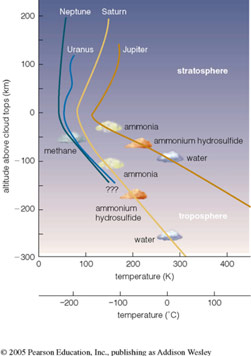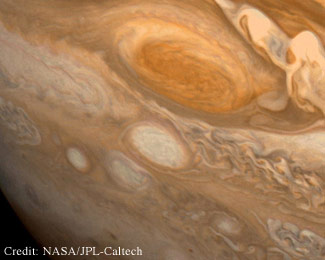
AtmospheresAtmospheres
Summary: All 4 jovian planets have distinct atmospheres with cloud layers that govern the different types of gases that can condense.
Atmospheric Structure and Clouds
Jovian Planet Weather
Climate and Weather on Jupiter
Related links
Related Lessons:
Great Red Spot Pinwheel
Happy Landings: A Splash or a Splat?
ATMOSPHERIC STRUCTURE AND CLOUDS

Cloud Altitudes
The atmospheric structures of the four jovian planets are all quite similar. The primary difference is that the atmospheres get progressively cooler with increasing distance from the Sun. Notice on the diagram that clouds of a particular composition always occur at about the same temperature. For example, the ammonia clouds on both Jupiter and Saturn form at an atmospheric temperature of about 150 K. This happens to be around 25 km below the cloud top on Jupiter and 100 km below the cloud top on Saturn.
Each jovian planet has distinct cloud layers, with altitudes dictated by the atmospheric levels at which various gases can condense into liquid droplets or solid flakes.
JUPITER AND SATURN CLOUD LAYERS:
- Ammonia clouds (150° K)
- Ammonium Hydrosulfide clouds (200° K)
- Water clouds (270° K)
Since Saturn's atmosphere is colder than Jupiter's at any particular altitude, the various cloud layers occur deeper within Saturn's atmosphere.
URANUS AND NEPTUNE CLOUD LAYERS:
Methane clouds (75 K)
Methane can condense in the very cold upper troposphere of Uranus and of Neptune, but not in the warmer troposphere of Jupiter or Saturn.
JOVIAN PLANET WEATHER

Jupiter's Weather Phenomena
Jupiter's weather phenomena (clouds, winds storms) are by far the strongest and most active of the jovian planets, but weather is found on all four.
Like Jupiter, Saturn has stripes of alternating color and wind direction, though in more subdued colors. Even though Saturn has an axis tilt similar to that of Earth, we don't see the dramatic seasons we might expect. Some weather changes have been observed, but Saturn's internal heat keeps temperatures about the same year-round and planet-wide.

Bands in Saturn's Atmosphere

Uranus
Uranus is essentially tipped on its side so we would expect it to go through extreme seasonal changes during its 84-year orbit around the Sun. When Voyager 2 flew past in 1986, Uranus's northern hemisphere was facing almost directly toward the Sun, and its southern hemisphere was in perpetual darkness. Photographs revealed virtually no clouds and no banded structures like those found on the other jovian planets. More recent observations show storms in Uranus's atmosphere. The storms may be brewing because of the changing seasons as the southern hemisphere sees sunlight for the first time in decades.
Neptune's atmosphere is banded, and has a high-pressure storm, called the Great Dark Spot, that is similar to Jupiter's Great Red Spot. The Great Dark Spot disappeared in 1994, but was replaced with a similar storm soon after. Like Saturn, Neptune has an axis tilt similar to Earth's but it has relatively little seasonal change because of its internal heat. The heat created in Neptune's interior is released uniformly and keeps the temperature about the same year-round and planet-wide.
CLIMATE AND WEATHER ON JUPITER
Jupiter's most famous feature is its Great Red Spot, which is visible in Jupiter's southern hemisphere. The Great Red Spot is more than twice as wide as Earth.
Jupiter has planet-wide circulation cells similar to those on Earth. Solar heat causes equatorial air to expand and fall toward the equator. The Coriolis effect splits the large equator-to-pole circulation cells into smaller cells. Jupiter's great size and fast rotation make the Coriolis effect very strong. Instead of being split into just three smaller cells encircling each hemisphere, as on Earth, Jupiter's circulation cells split into many alternating bands of rising and falling air. These bands of alternating color are dependent upon the chemical composition within each band, giving Jupiter a distinctly striped appearance.
Jupiter's climate is steady and most likely unchanging since it has no appreciable axis tilt and, therefore, no seasons. Solar heating alone might leave the poles relatively cool, but internal heat keeps the planet uniformly warm.
Jupiter Atmosphere Images at LASP
The Juno New Frontiers Mission Official Homepage


